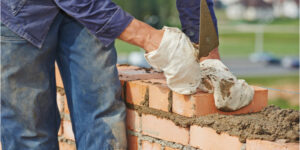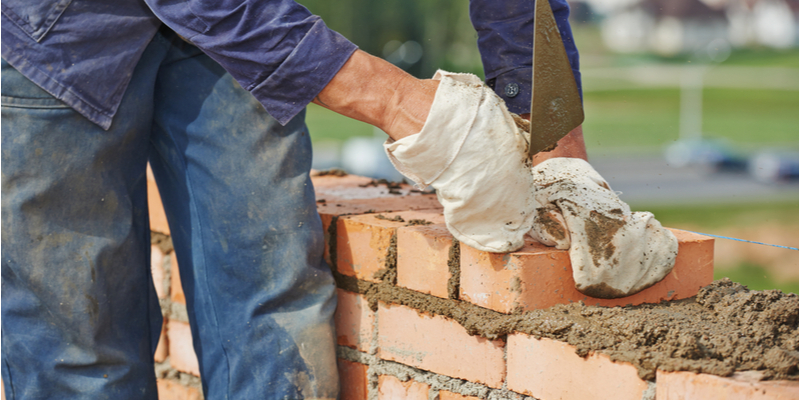Colorado Springs Masonry materials like brick, stone, and concrete are known for their strength. They can also be used to soundproof properties located near railroad tracks or other loud noises.
Brick is a popular construction material because it is durable and relatively inexpensive, especially when compared to other materials such as concrete. When used in conjunction with mortar, it can provide a strong and stable foundation for structures such as homes, buildings, and walls. Choosing the correct type of brick for a particular project is essential to ensuring quality and lasting construction. There are many different types of bricks, and each has its own advantages and uses.
Clay bricks are a popular choice for masonry projects. They are available in a variety of colors and textures, and they can be made to match the color scheme of a home or building. There are also a variety of sizes and shapes, with some even being modular. Modular bricks have actual dimensions that are close to standard, which simplifies the job of laying them in a wall.
Different types of brick are produced based on the type of clay and how it is fabricated. Some of the most common are soft-mud molded, dry-pressed, and extruded. Soft-mud-molded bricks are made from a mixture of clay and water and then formed into the desired shape. The bricks are then dried in a kiln before being fired.
This process produces hard and dense bricks, making them ideal for structural use. It is also possible to perforate the bricks using suitable dies, reducing their overall volume and thus lowering their cost. Perforated bricks are sometimes referred to as “hollow bricks,” although they can be solid or cellular. A brick may also be “frogged,” having indentations on one of the longer faces, or it can have a pattern that creates a herringbone pattern when the bricks are laid.
Engineering bricks are a high-density type of brick that is often used for basement foundations and sewers because of their impressive strength, low porosity, and resistance to chemical damage. They are often pressed in a dry-press system that begins with a thicker clay mix, producing bricks that have sharper edges when shaped. This method requires less water but is more expensive than the soft-mud molding process.
Stone
Stone is an attractive and durable building material. It has been used to build structures. Some of these structures have lasted for over 4,000 years and are still standing today. It is often used in combination with brick and concrete to provide a solid foundation for buildings and structures. It is also sometimes used for decorative purposes and to add an architectural element to a building.
Masonry is built using rough and irregularly shaped stones with mortar, either in a dry rubble form or in a dressed stone wall. A building constructed with dressed stone is called ashlar masonry, while a structure made of rubble stone is known as rubble or rough masonry. Dressed stone is more expensive than rubble, but it provides a smoother appearance and increased strength. It is used in corners, door and window sills, and other areas that require high structural integrity.
Another type of masonry is polygonal rubble masonry, which consists of a series of asymmetrically shaped stones with a number of facets and parallel sides.
A more modern building construction method is massive precut masonry, which uses precisely cut stone ashlars to speed up the laying process and reduce labor costs. The ashlars are numbered and arranged according to an architect’s plan, which masons can follow procedurally. They are dropped into place with a crane to speed construction and can be assembled into walls, lintels over windows and doors, or flat arches.
One disadvantage of constructing a building with masonry materials is that it takes longer than a property constructed from other materials. This is because the masonry requires mortar to set, which can take time to mix and apply. In addition, masonry can be difficult to work with during poor weather conditions, such as rain or snow. Therefore, it is important to create plans for how construction teams will remain productive during these types of weather conditions.
Concrete
Concrete is one of the most versatile and common building materials in the world, making it an ideal choice for masonry construction. It is a durable material that offers excellent fire resistance and can be combined with many other materials to create unique buildings. It also provides good insulation and is very cost-effective compared to other materials. It can be used to build foundations, walls, and columns. It is available in a variety of sizes and shapes, and it can be customized to meet specific needs.
Masonry can be built in a variety of ways, including using brick, block, or stone. It can also include composite masonry, which combines the best features of each type of masonry. For example, it can combine clay bricks with hollow concrete blocks or stone with solid concrete bricks. This allows architects to have greater flexibility and design freedom.
When constructing masonry, workers must be aware of the safety hazards associated with the work. These hazards can include falling from an elevated level, electrical hazards, being caught between objects, and being struck by equipment. In addition, masonry construction can produce high levels of dust and noise. Those working with concrete and masonry should wear protective gear to reduce the risk of exposure to these hazards.
Another safety hazard associated with masonry is exposure to respirable silica. This is a health risk that can be caused by grinding, cutting, or shaping concrete or masonry with power tools. It is important to use a vacuum system or other methods to capture and contain silica dust when working with these materials. In addition, workers should use a face mask when handling uncured concrete or masonry.
Masonry is typically constructed on footings, which are usually concrete structures but can also be made of beds of compacted gravel or crushed stone. These footings support the weight of the masonry walls above and must be wider than the walls themselves to spread their load evenly. This prevents the wall from sinking unevenly into the ground and cracking. In addition, a wider footing will help protect the masonry from damage during excavation and construction.
Mortar
While brick and stones get most of the attention when it comes to masonry, mortar is just as important. It is what holds bricks and stone together, giving structure to walls and other masonry structures.
Mortar is a paste-like binding material used in masonry. It combines cement and sand or other aggregates to create a workable mix that can be troweled, pressed, or poured between masonry blocks. A wide range of types and mixes are available, designed to suit specific masonry construction projects.
Most masons use cement-based mortar mixtures, although lime or other natural binding materials can still be used. The type and category of mortar applied to a project can have a significant impact on its long-term durability. The wrong type or category of mortar can result in wall cracks or even structural failure.
Bricks and other masonry materials need mortar to hold them in place, but it also fills gaps between bricks. It also helps ensure that brickwork remains smooth and level and that walls, chimneys, and other masonry structures stay plumb.
When choosing a mortar, consider its compressive and flexural strengths, as well as its exposure rating. A high compressive strength is necessary for load-bearing masonry, such as walls, while a low flexural strength is better for non-load-bearing applications like decorative stone or interior finishes. An appropriate exposure rating makes it easier for the masonry to shed water and resist moisture.
Mortar is available in bags or a dry, pre-mixed form that masons combine with water on-site using a mixer or other tool. It can be mixed with a hand tool, but mixers make the process much quicker and more efficient. If you’re planning to use a mixer, be sure to follow the manufacturer’s instructions regarding mixing ratios. For best results, mix the mortar for at least three minutes or longer to achieve a smooth blend with no water puddles or dry sections.
